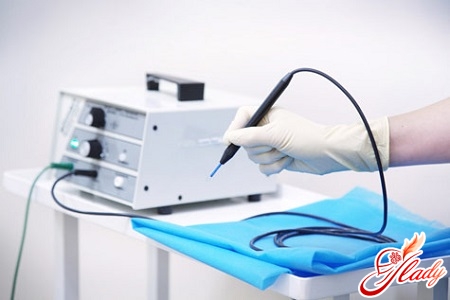
Cervical erosion is familiar to many womenby hearsay. Statistics say that every second woman of childbearing age has encountered this disease at least once in her life. Erosion is the formation of a wound on the epithelium of the cervix. In most patients, this pathology does not manifest itself with any symptoms and is discovered during a routine examination by a gynecologist. Occasionally, women who have been diagnosed with cervical erosion experience discomfort during sexual intercourse and complain of a periodically occurring slight pulling pain in the lower abdomen. A wound on the surface of the cervix rarely heals on its own and, if left untreated, threatens to develop into cancer. That is why it is so important to detect and treat this disease in time.

Indications for moxibustion: the beginning of the operation
Cauterization of cervical erosion is considered todaythe most effective method of treating this common female ailment. But it is possible only if the woman has not been diagnosed with any concomitant pathologies in addition to erosion. Before prescribing cauterization to his patient, the doctor must examine her vagina and cervix using a colposcope, and also take biopsy and cytology tests from the woman. The cauterization procedure is possible if the patient's cervical canal is in a normal condition and she has not been diagnosed with serious diseases such as advanced dysplasia or cervical cancer. Women who have been diagnosed with pathological processes in the cervix are often concerned about how erosion is cauterized. The cauterization procedure is performed in antenatal clinics, and is now also performed in private clinics. During the operation, the patient is positioned in a gynecological chair and is in exactly the same position as during a gynecological examination. The doctor inserts a special speculum into her vagina, which allows the entire cervix to be seen. After cleaning the woman's genitals with a swab, the gynecologist examines the cervix using a colposcope and detects defects that will need to be cauterized. After examining the cervix, the doctor anesthetizes the woman and begins the operation.
Elimination of electric shock by erosion
Of all the treatment methods that exist today,The oldest and most accessible method of treating this disease is diathermocoagulation, or cauterization of the pathology using high-frequency current. A method similar to this was used back in the 18th century. At that time, doctors used a device resembling a soldering iron for cauterization. Little has changed now. A device for diathermocoagulation is available in any antenatal clinic, so this type of treatment is most often prescribed to their patients by gynecologists. Doctors cauterize the erosion with electric current, after which a wound appears in its place, which after a certain time is covered with healthy epithelium. It happens that one procedure cannot completely cope with the pathology, in which case the woman is prescribed a second operation. Cauterization of cervical erosion with current is carried out in the second half of the monthly cycle. The procedure lasts about a quarter of an hour. A few hours after it, the woman is allowed to go home. During the operation, not only the area with the pathology is exposed to electric current, but also the healthy epithelium around it. The wound resulting from diathermocoagulation may take up to 2 months to heal. During this time, the patient is contraindicated from sexual activity. The woman must observe all hygiene rules, give up alcohol and cigarettes, and avoid lifting heavy objects. In order for the wound to heal faster after cauterization with electricity, doctors prescribe additional drug therapy to their patients. Cauterization of erosion with electric current has many negative aspects. The process itself is extremely painful and is performed under local, and sometimes general, anesthesia. After diathermocoagulation, a woman may experience transparent or bloody vaginal discharge, lower back pain, and general weakness for a month. As a result of cauterization with electricity, scars are formed on the mucous membrane of the cervix, which in the future may make it impossible for it to fully open during labor. Because of this, the diathermocoagulation method is contraindicated for young nulliparous women. The negative consequences of this method of treatment are: high risk of bleeding and the possibility of developing cervical endometriosis. In case of cervical erosion, cauterization with electricity is 92% effective. Relapses of the disease occur in 3-14% of cases.
Cauterization with liquid nitrogen
Some women's clinics have startedgradually abandon the painful and unsafe method of treating erosion with high-frequency current, replacing it with a safer cryodestruction, during which the pathology is cauterized with liquid nitrogen. This process is more like freezing - the wound on the surface of the epithelium is frozen, after which not even scars remain. Cryodestruction is acceptable for women of all ages, including young nulliparous girls. Nitrogen cauterization is not prescribed to patients who have severe ruptures or other deformations of the cervix. The procedure is suitable for treating small erosions (up to 3 cm in diameter); larger areas with pathologies are removed in other ways. Cauterization of cervical erosion with nitrogen is usually done without anesthesia. However, this treatment method cannot be called completely painless - a woman may feel severe spasms in the uterus during the operation. Cryodestruction is performed in the first days after the end of menstruation. There is a risk of severe bleeding during and after the procedure, but it is minimal. After this type of cauterization, most women may experience hydrorrhea for some time - abundant transparent vaginal discharge. For complete restoration of the cervical mucosa, women who have undergone cryodestruction are prohibited from having sexual intercourse for at least a month after it. The effectiveness of the method is 90%, every tenth woman fails to remove erosion after one procedure and cryodestruction must be repeated again.
Treatment of laser erosion
In most countries of the world, cervical erosionare eliminated using the laser destruction method. Laser cauterization allows for a targeted effect on the pathology without endangering the healthy epithelium. Laser treatment of cervical erosion is 98% effective, and relapses are extremely rare. While cryodestruction is only permitted for small affected areas, laser cauterization is acceptable for treating extensive erosions (3 cm or more). The method is used to treat both women who have given birth and women who have not, and it leaves no scars. Laser destruction is performed under local anesthesia - the doctor injects the cervix with an anesthetic drug using a syringe with a very thin needle. Women often experience bleeding after cauterization, so for rapid recovery of the mucous membrane, specialists recommend that patients abstain from sexual intercourse for a month and do not use tampons. In order to reduce the risk of infection, women are prohibited from visiting swimming pools and saunas, swimming in rivers, or taking baths. Laser destruction is a gentle method of treating cervical erosion, but the equipment for this operation is currently available mainly in private clinics.
Radio waves - a new word in the treatment of erosion
New methods of combating erosion include:refers to the radio wave method of treating this disease. In Russia, cauterization of erosion with radio waves is practically not carried out, since this operation requires a special American-made device "Surgitron". The radio waves generated by this device are used to treat the epithelial tissue damaged by erosion. The advantage of the method is the painlessness of the procedure and the short period of restoration of the cervical cells. The operation is performed without accompanying bleeding and injury to the healthy epithelium located next to the pathology. In diseases of the cervix, radio wave treatment does not turn wounds into scars, so the method is indicated for all women of childbearing age. Contraindications to the use of radio wave surgery are the presence of a pacemaker in a woman, inflammatory processes in the pelvic organs. In all other cases, radio waves are considered safe and are not capable of causing harm to the female body. After the procedure, scanty discharge mixed with blood may come out of the woman's vagina for a short period. Sometimes patients complain of pain similar to menstrual pain. However, these symptoms disappear within a few days after the erosion is removed with radio waves. The woman should refrain from intimacy for 10 days, during which time the uterine mucosa should fully recover. In addition to cauterizing erosion, the Surgitron device is used to treat a number of other cervical diseases. Radio wave treatment is considered the most effective and safe method today. Its only drawback is its high cost. The question of which method of cauterizing cervical erosion to prescribe to a woman is decided by her doctor. In doing so, he takes into account the age of his patient, her desire to have a child in the future, and the presence of concomitant diseases. It is very important that a woman does not delay treatment of her illness, does not self-medicate and remembers that timely cauterization can save her from a very terrible disease - cervical cancer.









